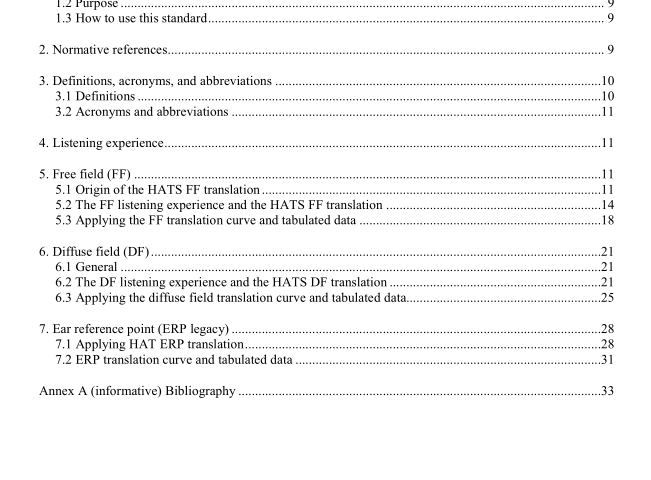IEEE 1652-2016 pdf download.IEEE Standard for Translating Head and Torso Simulator Measurements from Eardrum to Other Acoustic Reference Points
This standard provides the data, techniques, and rationale for translating head and torso simulator measurements from the eardrum to other acoustic reference points, such as the free field and the diffuse field.
It applies primarily to measurements of devices that contact the ear, such as headsets and handsets. It can also be used for devices that do not contact the ear, such as speakerphones and wearable devices. It is applicable to communication and multimedia audio devices over the frequency range of 20 Hz to 20 kHz
1.2 Purpose
Common acoustic reference points are needed for comparing electroacoustic performance of handsets, headsets, speakerphones and other kinds of communication devices. It is also needed for comparing communication devices with other devices such as loudspeakers, multimedia terminals and consumer audio equipment.
The free field and diffuse field are appropriate reference points because the results relate closely to what we hear. For measurements on communication devices, the free field or diffuse field are more widely applicable reference points than the legacy ear reference point (ERP).
1.3 How to use this standard
When reading this standard for the first time, it is helpful to begin with Clause 4 and read the remainder of the document. When applying the standard, go to the applicable clause and use the tables as instructed.
2. Normative references
The following referenced documents are indispensable for the application of this document (i.e., they must be understood and used, so each referenced document is cited in text and its relationship to this document is explained). For dated references, only the edition cited applies. For undated references, the latest edition of the referenced document (including any amendments or corrigenda) applies.
ITU-T Recommendation P.57, Artificial Ears.
ITU-T Recommendation P.58, Head and Torso Simulator for Telephonometry.
3. Definitions, acronyms, and abbreviations
3.1 Definitions
For the purposes of this document, the following terms and definitions apply. The IEEE Standards Dictionary Online should be consulted for terms not defined in this clause.
diffuse field (DF): Sound field in which the time average of the mean-square sound pressure is the same everywhere and the flow of acoustic energy in all directions is equally probable.
ear reference point (ERP): A virtual point for acoustic and geometric reference located outside the entrance to the ear canal. The exact location is specified for each type of ear simulator.
eardrum reference point (DRP): A point located at the end of the ear canal, corresponding to the ear- drum position. Also known as the drum reference point. free field (FF): (A) Sound field in a homogenous, isotropic medium free from boundaries. In practice, the effects of boundaries on a free field are negligible over the region of interest. (B) (Simple definition) Sounds field free of reflections.
frequency response: Electrical, acoustic, or electroacoustic sensitivity (output/input), or gain, as a function of frequency.
head and torso simulator (HATS) for telephonometry: A manikin incorporating a mouth simulator and ear simulator(s), extending downward from the top of the head to the waist, designed to simulate the sound pick-up characteristics and acoustic diffraction produced by a median human adult and to reproduce the acoustic field generated by the human mouth.
NOTE—See ITU-T Recommendation P.58. 3 orthotelephonic: A talker and a listener communicating by speech, face to face, one meter apart, in a quiet, approximately anechoic environment.
receiver: An electroacoustic transducer that converts an electrical signal to sound and delivers it directly to the ear, sealed or unsealed.
speaker (also loudspeaker): An electroacoustic transducer that converts an electrical signal to sound and delivers it to the ear from a distance of several centimeters or greater.IEEE 1652 pdf download.IEEE 1652-2016 pdf download
IEEE 1652-2016 pdf download

Leave a Reply